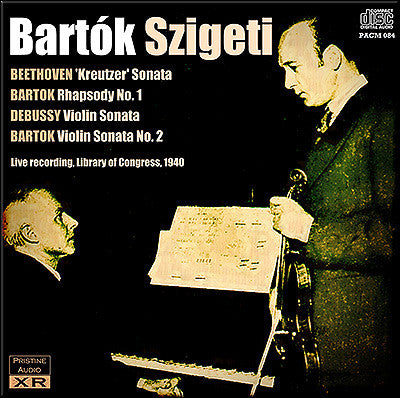
This album is included in the following sets:
This set contains the following albums:
- Producer's Note
- Full Track Listing
- Cover Art
Bartók and Szigeti's Library of Congress concert in jaw-dropping live sound
"This is, quite simply, one of the greatest concerts ever recorded" - ClassicalNotes.com
Working from near-mint LP pressings from two different sources, my aim here was to highlight what one reviewer referred to as Szigeti's tone "in all its steely glory", whilst dealing with myriad issues: "electrical turntable rumble, occasional swish and pops and crackles and the other by-products of such a recording". I was also able to cure a number of issues relating to wow, and reveal from the rather dim-sounding records that actually a huge amount of detail had been captured and preserved on the original acetates by the impromptu actions of Harold Spivacke, Director of the Music Division of the Library of Congress at the time, who had the foresight to preserve this remarkable concert.
The effect upon the recording of XR remastering, particularly when heard in the Ambient Stereo version, is quite stunning. Despite the occasional reminder of its age, the performance is now more vivid, vicseral and alive, with a fabulously extended frequency range that conveys brilliantly the tone and performance of both musicians.
Andrew Rose
- BEETHOVEN Violin Sonata No. 9 in A, Op. 47, "Kreutzer"
- BARTOK Rhapsody No. 1 for Violin & Piano
- DEBUSSY Sonata for Violin and Piano
-
BARTOK Second Sonata for Violin and Piano
Recorded at the Coolidge Auditorium, Library of Congress, Washington DC on April 13, 1940
Transfers from Philips AL3542 and Vanguard SRV-304/5 LPs
XR remastering by Andrew Rose at Pristine Audio, July-August 2012
Cover artwork based on a photograph of Bartók and Szigeti, taken in Berlin in 1929
This release preserves the original order of the performance. We are grateful to Cary O'Dell, Boards Assistant, Motion Picture, Broadcasting and Recorded Sound Division at the Library of Congress for additional and swift research in this matter.
Total duration: 69:43
Joseph Szigeti, violin
Béla Bartók, piano
Classical Notes historic review
This is, quite simply, one of the greatest concerts ever recorded
Most of us tend to think of chamber music as a sterile affair in which refined musicians gently amuse a staid group of corseted ladies and starched gentlemen amid lavish splendor. Pretty dull stuff. A few minutes of this disc should forever demolish such an absurd myth.
This is, quite simply, one of the greatest concerts ever recorded. Blazing with passion, it ranks right up there with Benny Goodman at Carnegie Hall, James Brown at the Apollo, the Allman Brothers at the Fillmore, or your own sweat-drenched favorite. As with most such events, its supreme quality arose from a unique confluence of forces, a single moment in time that would never recur.
Joseph Szigeti, one of the most acclaimed violinists of the century, was a fervent advocate of modern music. Bela Bartok was not only an accomplished pianist but one of the most influential composers of his era. Both were life-long friends, allied by their ardent nationalism and anti-fascism, who emigrated to America. Szigeti came first. Bartok arrived on April 11, 1940. This recital two days later was their first in the New World.
Both deeply loved their native land. Each had devoted decades to collecting and perpetuating its musical traditions and had become Hungary's greatest musicians. Although now physically safe in America, they were keenly aware that the world they had left behind was on the brink of extinction. It was with that crushing burden that they transplanted their culture to a new, hopefully temporary home, in the symbolic form of a recital at the Library of Congress, the shrine of intellectual freedom. (Although Szigeti lived until 1973, Bartok would die in exile in New York in 1945, never again seeing his country.) Both the style and the content of the recital seethed with emotional significance. This concert was nothing less than a deeply personal plea for an entire culture that was about to evaporate.
Both musicians were not only ideal spokesmen and advocates for their national music but exemplified the entire Eastern European approach to interpretation, perhaps the most viscerally exciting of all classical performing traditions. Intonation, rhythm, dynamics and texture all become wildly distorted to produce an uninhibited gypsyish emotional effect. While such stylistic matters are hard to describe, the first minute of the Bartok Rhapsody will explain this unbuttoned approach better than a thousand books.
The style is no longer familiar and takes considerable adjustment for modern ears. At first, it sounds sour. Fingers and toes can be exhausted in a matter of seconds keeping count of all the "wrong" notes. But are they really wrong? Not at all. As with blue notes in jazz or microtones in blues, this music yields to emotion. The bent notes are not mistakes, but rather the expressive means by which the artists convey their unbounded feelings.
Admittedly, this is not the accepted way to perform classical music. By what right do these performers so arrogantly distort the published score? For two of the works performed here, the answer is obvious: Bartok wrote them and considered Szigeti to be their foremost exponent. This disc documents nothing less than the creator's legacy. Any differences between the score and these unbridled preformances clearly yields to the latter as a living, breathing record of the composer's intention...
Peter Gutmann - ClassicalNotes.com, 1995 (excerpt)

